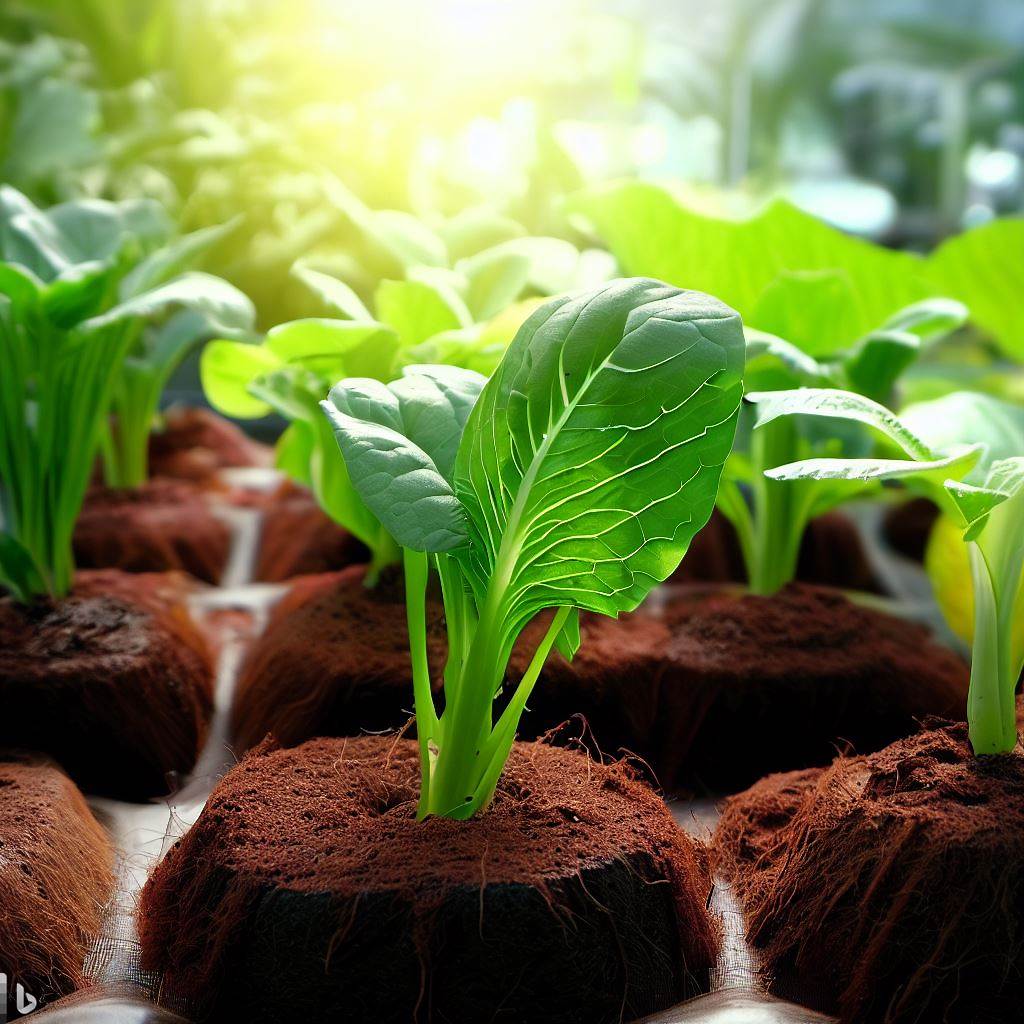
As a passionate home gardener, I am always on the lookout for sustainable solutions to enhance the growth and yield of my vegetables. One such solution that has proven to be incredibly beneficial is coco peat. Coco peat, also known as coir pith or coir dust, is a byproduct of the coconut industry and is widely used as a growing medium. In this article, I will explore the advantages of using coco peat for growing vegetables and why it is a sustainable option for home gardeners.
What is Coco Peat and How is it Made?
Coco peat is derived from the husk of coconuts. After the coconuts are harvested, the husks are removed and soaked in water for several months. This process helps to break down the husks and separate the fibers from the pith. Once the fibers are removed, the remaining pith is dried and processed into coco peat. The end result is a lightweight and highly absorbent material that is perfect for growing vegetables.
Advantages of Using Coco Peat for Growing Vegetables
There are numerous benefits to using coco peat as a growing medium for vegetables. Firstly, coco peat has excellent water retention properties. It can hold up to 10 times its weight in water, ensuring that your plants have a constant supply of moisture. This is particularly beneficial in regions with dry climates or for gardeners who may not have the time to water their plants frequently.
Secondly, coco peat has excellent aeration properties. It is made up of small particles that allow for ample airflow to the roots of your plants. This helps to prevent root rot and encourages healthy root development. Additionally, coco peat is pH neutral, which means that it does not alter the pH of your soil. This is important for growing vegetables as different plants have different pH requirements.
Lastly, coco peat is a renewable resource. It is a byproduct of the coconut industry and would otherwise go to waste. By using coco peat in your garden, you are not only benefiting your plants but also contributing to a more sustainable and environmentally friendly gardening practice.
It has many advantages, such as:
- It is organic and eco-friendly, meaning it will not harm the environment or the plants.
- It is lightweight and porous, allowing air and water to circulate freely and preventing root rot and fungal diseases.
- It is absorbent and retains moisture, reducing the need for frequent watering and fertilizing.
- It is pH neutral and nutrient rich, providing a balanced and healthy environment for the plants.
- It is easy to use and store, as it comes in compressed blocks that can be rehydrated and expanded when needed.
Some drawbacks of using coco peat as a growing medium are:
- It can be expensive and hard to find, as it is not widely available in some regions.
- It can also contain high levels of salt, which can harm the plants if not washed properly before use.
- It can be prone to pests and weeds, which can compete with the plants for nutrients and space.
Coco Peat as a Sustainable Gardening Solution
In recent years, there has been a growing concern about the environmental impact of traditional gardening practices. The use of synthetic fertilizers and pesticides has led to soil degradation and water pollution. As a result, many home gardeners are looking for more sustainable alternatives.
Coco peat offers a sustainable solution for home gardeners. Unlike traditional soil, coco peat does not require the use of synthetic fertilizers or pesticides. It is naturally rich in nutrients and beneficial microorganisms that promote plant growth. This means that you can grow your vegetables organically, without the need for harmful chemicals.
Furthermore, coco peat is a renewable resource. By using coco peat in your garden, you are reducing the demand for traditional soil and contributing to the conservation of natural resources. This makes it an excellent choice for eco-conscious gardeners who want to minimize their environmental footprint.
How to Use Coco Peat for Growing Vegetables
Using coco peat for growing vegetables is incredibly easy. First, you will need to rehydrate the coco peat. Simply add water to the dry coco peat and allow it to soak for a few hours. Once the coco peat has absorbed the water and expanded, it is ready to use.
Next, prepare your pots or garden beds by filling them with the rehydrated coco peat. You can also mix coco peat with traditional soil in a 1:1 ratio for added benefits. Make sure to provide adequate drainage by adding a layer of gravel or small stones at the bottom of your containers.
Now, you can plant your vegetable seeds or seedlings directly into the coco peat. Make sure to space them out according to the specific requirements of each vegetable. Water your plants regularly to keep the coco peat moist, but be careful not to overwater as this can lead to root rot.
Tips for Maximizing the Benefits of Coco Peat in Your Garden
To maximize the benefits of coco peat in your garden, here are a few tips to keep in mind:
- Use coco peat in combination with organic fertilizers to provide your plants with a balanced nutrient supply.
- Mix coco peat with traditional soil to improve the structure and water-holding capacity of your garden beds.
- Regularly monitor the moisture levels of your coco peat and adjust your watering schedule accordingly.
- Consider using coco peat as a mulch around your vegetable plants to help retain moisture and suppress weeds.
- Reuse and recycle your coco peat. After each growing season, you can compost the used coco peat or use it as a soil amendment in your garden.
By following these tips, you can ensure that you are getting the most out of your coco peat and enjoying a bountiful harvest of vegetables.
Common Misconceptions about Coco Peat
While coco peat offers numerous benefits, there are some common misconceptions that need to be addressed. One of the most prevalent misconceptions is that coco peat is acidic. In reality, coco peat is pH neutral and does not affect the pH of your soil. However, it is important to note that coco peat may initially have a high salt content, which can affect the growth of sensitive plants. To mitigate this, it is recommended to rinse the coco peat thoroughly before using it.
Another misconception is that coco peat does not provide adequate support for plants. While it is true that coco peat is a lightweight material, it can still provide sufficient support for most vegetables. However, for plants with heavy fruit or large root systems, it is advisable to provide additional support such as stakes or trellises.
Where to Buy Coco Peat for Vegetable Gardening
Coco peat is readily available at garden centers, nurseries, and online stores. When purchasing coco peat, make sure to look for high-quality products that are free from contaminants and have been properly processed. It is also important to check the moisture content of the coco peat, as overly dry or wet coco peat may not be suitable for growing vegetables. We also can export coco peat from Indonesia in bulk for 20′ or 40′ dry container.
Case Studies: Success Stories of Using Coco Peat in Vegetable Gardens
To showcase the effectiveness of coco peat for growing vegetables, let’s take a look at a few success stories from home gardeners:
- Sarah, a home gardener from California, used coco peat in her raised beds and saw a significant increase in the yield of her tomatoes and peppers. The coco peat helped to retain moisture in the soil, resulting in healthier plants and larger fruits.
- John, a beginner gardener from Florida, struggled with sandy soil that drained too quickly. By incorporating coco peat into his soil, he was able to improve its water-holding capacity and grow a wide variety of vegetables successfully.
- Lisa, an urban gardener from New York City, used coco peat in her container garden on her balcony. The lightweight nature of coco peat made it easy for her to move her pots around, and she was able to grow a thriving vegetable garden in a limited space.
These success stories highlight the versatility and effectiveness of coco peat as a growing medium for vegetables.
Conclusion: Why Coco Peat is a Sustainable and Effective Option for Home Gardeners
In conclusion, coco peat offers numerous benefits for home gardeners who are looking for a sustainable solution for growing vegetables. Its excellent water retention and aeration properties, pH neutrality, and renewable nature make it an ideal choice for eco-conscious gardeners. By using coco peat, you can enhance the growth and yield of your vegetables while minimizing your environmental footprint.
So, if you’re ready to take your vegetable garden to the next level, give coco peat a try. You won’t be disappointed with the results!
CTA: Start using coco peat in your vegetable garden today and experience the sustainable benefits for yourself. Transform your garden into a thriving oasis of fresh and delicious vegetables.







